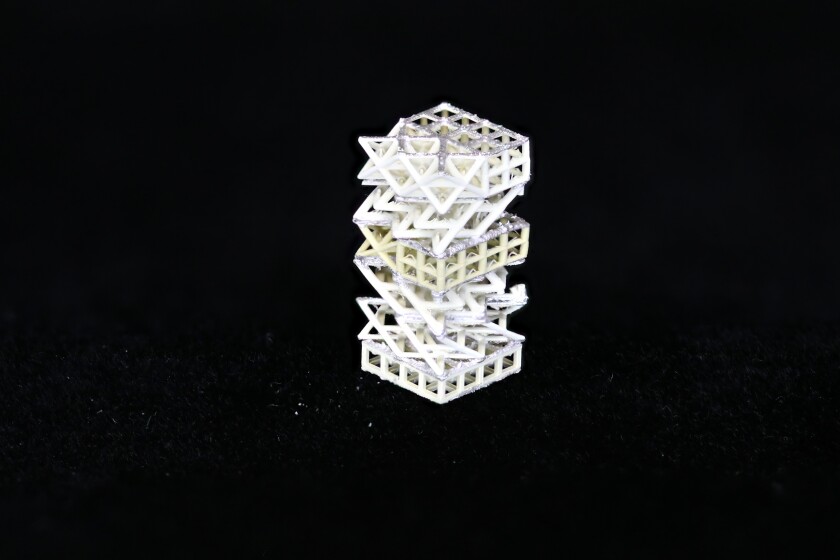Building a robot is hard. Building one that can sense its environment and learn how to get around on its own is even harder.
But UCLA engineers took on an even bigger challenge. Not only did they create autonomous robots, they 3-D printed them in a single step.
Each robot is about the size of a fingertip. Their bodies resemble a bamboo mat folded in the shape of an N, and they glide around at speeds of up to 25 feet per minute.
What made the feat possible was the invention of a new kind of all-in-one material that’s capable of bending, twisting, flexing and stretching.
“Traditional robots you see today rely on multiple different components,” said Rayne Zheng, a mechanical engineer and leader of the project. The robot’s body, its moving parts, and its electronics have to be built separately and then assembled together. “With 3-D-printed materials that can be robotized, we don’t need any of that.”
The advance, described last month in the journal Science, paves the way for inventions ranging from nimble rescue robots able to navigate tight spaces to responsive prosthetics with fewer pieces that can break.
VIDEO | 04:48
Tiny 3-D-printed robots developed at UCLA could become critical in rescue missions

UCLA researchers have developed materials that allow tiny robots to become autonomous after receiving basic commands.
“A lot of times, 3-D printing is kind of used as a novelty to generate hype … but that’s not the case here,” said Ryan Sochol, a robotics engineer at the University of Maryland who was not involved in the study.
Robert MacCurdy, who designs automated robots at the University of Colorado Boulder, called the UCLA work “a real innovation in 3-D printing technology.” He said the printing of a mobile, shape-shifting material with built-in electronic components and remote sensing capabilities has not been achieved before, and it foreshadows “the production of robots in the future.”
Zheng and his colleagues embarked on the project three years ago to see if they could use 3-D printing to build a material capable of sensing its environment — to measure the surrounding temperature, for instance, and to notice if it was struck or being squished.
Once they met that goal, they added another. “We started to think, in addition to sensing, why not make it move?” Zheng said.
And they still wanted to do it all in a single step.
Ordinary 3-D printers work like a machine that adds icing to a cake. They build up thin layers of plastic, metal, glass or other materials to produce an endless list of products such as jewelry, tools, prosthetics and even pizza. But they can only print one component at a time.
To print an entire robot at once, Zheng and his colleagues needed a versatile material. So they created one out of silicon carbide, which supports the robots’ structure; electrodes made of copper and gold, which carry current; and piezoelectric ceramics, which change shape in response to an electric field.
Each part contributes to a whole new “metamaterial” that can bend and flex, stretch and squeeze, and twist and turn, said Huachen Cui, a postdoctoral researcher in Zheng’s lab who spearheaded its development. And the metamaterial can be 3-D printed in one go.
The new material required a custom 3-D printer, so the team built one that takes up the space of an office desk. The way it works is similar to flash-freezing a design in a glass of water and draining away the rest of it, leaving an intricate ice sculpture behind. But instead of water, the printer alternates between vats of the three ingredients, then uses ultraviolet light to solidify each layer of the metamaterial lattice as the robot takes shape.

A close-up of the 3-D-printed lattice that forms the basis of the robots. The intricate elements are designed to bend, flex, twist, rotate, expand or contract at high speeds.
(Rayne Research Group/UCLA)
The result is basically like a muscle. “It has everything integrated from structural components, sensing components, all the way to motion and electronic control,” Zheng said.
In other words, MacCurdy said, it’s a truly functional object: “When it comes out of the 3-D printer, it doesn’t require additional assembly.”
Cui put a robot through its paces by placing it on a table between a pair of pipes. A set of wires tethered the robot to a power source. When the power was switched on, the robot sparked to life with an uncharacteristic bright green flash accompanied by wisps of smoke. But soon it was moving with the soft buzzing hum of an electric shaver.
The three parts of its N-shaped body form a muscle that flexes faster than the eye can discern, propelling it forward with ease. It can even jump over tiny hurdles about 1 millimeter high.
The design was inspired by nature.
“I wanted to make it agile and very fast — the first thing I could think about was a leopard,” said Cui, who was the study’s lead author. “You just need to hit the ground and move forward. That’s it.”
The robots rely on ultrasound to sense their surroundings, like bats. But instead of using echolocation, the machines employ a 3-D-printed remote sensor that bounces radar pulses in various directions. The way they bounce back alerts the robot to obstacles in its path so it can adjust accordingly.
The machines, which are small enough to fit on a penny, can carry more than 13 times their own weight. When Cui dropped a bolt into a basket affixed to the top of the robot, it jolted and started moving faster. The impact, meant to mimic falling debris, was its cue to make a quick escape, he said.
Zheng said it wouldn’t be hard to make the robots bigger — all they’d need is a bigger 3-D printer. The real challenge is to make the robots smaller, and capable of operating in water.
This is something that excites Sochol.
“I think biomedical applications, particularly drug delivery, is an application where this could really have a legitimate use,” he said. He envisioned a scenario in which a tiny robot carries a dose of medicine to a particular location in a blood vessel. Once it’s in position, doctors could “hit it with an electric field” to get it to release its payload.
Zheng’s lab is already outfitted with a small tank on the floor to test a future generation of aquatic robots. If a leopard inspired the original version, the new ones will be designed to mimic the swimming and crawling abilities of shrimp.

